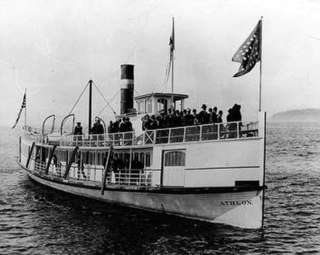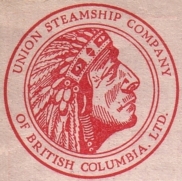
Athlon was a typical passenger steamboat of the Puget Sound Mosquito Fleet.

The steamboat Monticello (2) operated in the early 1900s as part of the Puget Sound Mosquito Fleet. The vessel went through several reconstructions and remained in service until 1962, when she was lost in Alaska waters. Her later names were Penaco and Sea Venture. (This Puget Sound steamer should not be confused with the smaller Monticello, which also ran on Puget Sound, but was built in 1895 for Captain Z.J. Hatch of the Monticello Steamship Company.

The steamboat Rosalie operated from 1893 to 1918 as part of the Puget Sound Mosquito Fleet, also operating out of Victoria, B.C. In 1898, Rosalie went north with many other Puget Sound steamboats to join the Klondike Gold Rush.

Asbury Park was a high-speed coastal steamer built in Philadelphia, and intended to transport well-to-do persons from New York to summer homes on the New Jersey shore. This vessel was sold to West Coast interests in 1918, and later converted to an automobile ferry, serving on various routes San Francisco Bay, Puget Sound and British Columbia. This vessel was known by a number of other names, including City of Sacramento, Kahloke, Langdale Queen, and Lady Grace.

The Union Steamship Company of British Columbia was a pioneer firm on coastal British Columbia. It was founded in November 1889 by John Darling, a director of the Union Steamship Company of New Zealand, and nine local businessmen. The company began by offering local service on Burrard Inlet near Vancouver and later expanded to servicing the entire British Columbia coast.

Tacoma was a steamship that served from 1913 to 1938 on Puget Sound. Built of steel, Tacoma was known for being one of the fastest and best-designed vessels to operate on Puget Sound. Tacoma was particularly noted for high-speed service from 1913 to 1930 on the route between Tacoma and Seattle.

Hyak was a wooden-hulled steamship that operated on Puget Sound from 1909 to 1941. This vessel should not be confused with the sternwheeler Hyak which ran on the extreme upper reach of the Columbia River at about the same time. The name means "swift" or "fast" in the Chinook Jargon.
Elk was a steam tug that operated on Puget Sound, and earlier, from 1880 to 1896, on Lake Washington under the name of Katherine.

Richard Holyoke was a seagoing steam tug boat built in 1877 in Seattle, Washington and which was in service on Puget Sound and other areas of the northwest Pacific coast until 1935. The vessel was considered to be one of the most powerful tugs of its time.

Otter was a wooden sternwheel steamboat that was used in Puget Sound and briefly on the Columbia and Stikine rivers from 1874 to 1897.

Alice Gertrude was a wooden steamship which operated on the Strait of Juan de Fuca and Puget Sound from 1898 to January 1907, when she was wrecked at Clallam Bay in Washington.

Dode was a steamboat that ran on Hood Canal and Puget Sound from 1898 to 1900.

Inland Flyer was a passenger steamboat that ran on Puget Sound from 1898 to 1916. From 1910 to 1916 this vessel was known as the Mohawk. The vessel is notable as the first steamer on Puget Sound to use oil fuel. Inland Flyer was one of the most famous vessels of the time on Puget Sound.

General Miles was a steamship constructed in 1882 which served in various coastal areas of the states of Oregon and Washington, as well as British Columbia and the territory of Alaska. It was apparently named after US General Nelson A. Miles.

Kulshan was a steamship which operated on Puget Sound from 1910 until 1929. When built, Kulshan was one of a newer type of inland steamships constructed entirely of steel, and was then considered one of the finest vessels ever to operate on Puget Sound.

Sol Duc was a steamship which was operated on northern Puget Sound from 1912 to 1935, chiefly on a route connecting ports on the Olympic Peninsula with Seattle. During the Second World War (1941-1945) Sol Duc served as a barracks ship.

Sioux was a steamship which was operated on Puget Sound and the Strait of Juan de Fuca from 1912 to 1941. From 1924 to 1941, following reconstruction, the vessel operated as an auto ferry under the name Olympic. During the Second World War (1941-1945) this vessel was taken under the control of the U.S. Army and renamed the Franklin R. Leisenburg. The Liesenburg served as a ferry in the Panama Canal area under Army control, and then was sold to a firm which ran the vessel on the Surinam river in South America.

Camano was a steamboat built in 1906 at Coupeville, Washington which operated on Puget Sound from 1906 to 1917. Camano was later known as Tolo. As Tolo the vessel was sunk in 1917 as a result of a collision at sea. Four people died as a result.

Atlanta was a steamboat built in 1908 at Houghton, Washington which served on Lake Washington and Puget Sound until 1938, when it was converted into a diesel-powered houseboat.

Princess Beatrice was a steamship built for and owned by the marine division of the Canadian Pacific Railway. The ship served from 1903 to 1928 in the coastal waters of British Columbia. The ship also operated on Puget Sound on a route from Victoria, British Columbia to Seattle, Washington. Princess Beatrice was the first ship to operate in the year-round steamship service between Seattle and Victoria that was run by CPR from 1904 to 1959. This ship should not be confused with an earlier Princess Beatrice, built in Scotland in 1874, which served on the Atlantic coast of Canada.



















